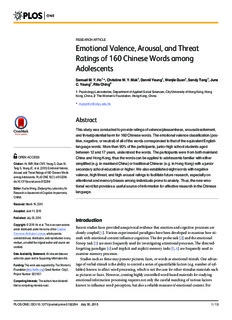
Emotional Valence, Arousal, and Threat Ratings of 160 Chinese Words among Adolescents PDF
Preview Emotional Valence, Arousal, and Threat Ratings of 160 Chinese Words among Adolescents
RESEARCHARTICLE Emotional Valence, Arousal, and Threat Ratings of 160 Chinese Words among Adolescents SamuelM.Y.Ho1*,ChristineW.Y.Mak1,DanniiYeung1,WenjieDuan1,SandyTang1,June C.Yeung1,RitaChing2 1 PsychologyLaboratories,DepartmentofAppliedSocialSciences,CityUniversityofHongKong,Hong Kong,China,2 TheWomen’sFoundation,HongKong,China * [email protected] Abstract Thisstudywasconductedtoprovideratingsofvalence/pleasantness,arousal/excitement, andthreat/potentialharmfor160Chinesewords.Theemotionalvalenceclassification(pos- itive,negative,orneutral)ofallofthewordscorrespondedtothatoftheequivalentEnglish languagewords.Morethan90%oftheparticipants,juniorhighschoolstudentsaged between12and17years,understoodthewords.Theparticipantswerefrombothmainland OPENACCESS ChinaandHongKong,thusthewordscanbeappliedtoadolescentsfamiliarwitheither Citation:HoSMY,MakCWY,YeungD,DuanW, simplified(e.g.inmainlandChina)ortraditionalChinese(e.g.inHongKong)withajunior TangS,YeungJC,etal.(2015)EmotionalValence, secondaryschooleducationorhigher.Wealsoestablishedeightwordswithnegative Arousal,andThreatRatingsof160ChineseWords valence,highthreat,andhigharousalratingstofacilitatefutureresearch,especiallyon amongAdolescents.PLoSONE10(7):e0132294. doi:10.1371/journal.pone.0132294 attentionalandmemorybiasesamongindividualspronetoanxiety.Thus,thenewemo- tionalwordlistprovidesausefulsourceofinformationforaffectiveresearchintheChinese Editor:XuchuWeng,ZhejiangKeyLaborotoryfor ResearchinAssesmentofCognitiveImpairments, language. CHINA Received:March19,2015 Accepted:June11,2015 Published:July30,2015 Introduction Copyright:©2015Hoetal.Thisisanopenaccess Recentstudieshaveprovidedunequivocalevidencethatemotionandcognitiveprocessesare articledistributedunderthetermsoftheCreative closelycoupled[1].Variousexperimentalparadigmshavebeendevelopedtoexaminehowsti- CommonsAttributionLicense,whichpermits unrestricteduse,distribution,andreproductioninany muliwithemotionalcontentinfluencecognition.Thedotprobetask[2]andtheemotional medium,providedtheoriginalauthorandsourceare Strooptask[3]aremostfrequentlyusedforinvestigatingattentionalprocesses.Thedirected- credited. forgettingparadigm[4]andimplicitandexplicitmemorytasks[5,6]arefrequentlyusedto DataAvailabilityStatement:Allrelevantdataare examinememoryprocesses. withinthepaperanditsSupportingInformationfile. Studiessuchasthesemaypresentpictures,faces,orwordsasemotionalstimuli.Oneadvan- Funding:ThisworkwassupportedbyTheWomen’s tageofverbalstimuliistheabilitytocontrolaseriesofquantifiablefactors(e.g.numberofsyl- Foundation(http://twfhk.org/)GrantNumber:CityU, lables)knowntoaffectwordprocessing,whichisnotthecaseforotherstimulusmaterialssuch ProjectNumber:9231137. aspicturesorfaces.However,creatinghighlycontrolledword-basedmaterialsforstudying emotionalinformationprocessingrequiresnotonlythecarefulmatchingofvariousfactors CompetingInterests:Theauthorshavedeclared thatnocompetinginterestsexist. knowntoinfluencewordperception,butalsoareliablemeasureofemotionalcontent.For PLOSONE|DOI:10.1371/journal.pone.0132294 July30,2015 1/13 ChineseEmotionalWords instance,BradleyandLang[7]producedtheAffectiveNormsforEnglishWords(ANEW), whichprovideasetofnormativeemotionalratingsforalargenumberofwords.Studiesinves- tigatingcognitivebiaseshavealsoprovidedmanyappropriatewords[8–11].Theavailabilityof suchstimulimakesthereplicationofresultsandscientificcommunicationeasierandcompara- tivestudieswithdifferentcategoriesofstimuliandsensorialmodalitiespossible.Affective wordlistshavebeendevelopedinotherlanguagesapartfromEnglish,includingFinnish[12], Spanish[13,14],German[15],Italian[16],EuropeanPortuguese[17],andDutch[18].Like theirEnglishlanguagecounterparts,thesenon-English-languageaffectivewordlistshavebeen widelyusedinmemoryandperceptionexperiments.Forexample,OnraedtandKoster[19] usedaDutchaffectiveworddatabaseinastudyofworkingmemory,whereasSiakaluk,Knol, andPexman[20]adoptedthevalenceandarousalratingsofaffectivewordsasthestimuliin theStrooptask. Threecomponentsofemotionarecommonlyused[21]:thevalenceorpleasantnessofthe stimuli;thearousalorexcitementprovokedbythestimuli;andthedominanceordegreeof controlexertedbythestimuli.Ofthese,emotionalvalencehasbeenidentifiedasthemostpow- erfulmeasureoftheemotionalnatureofstimuli,andhasalsobeenshowntocapturecognitive resourcessuchasattention[22,23].Thelevelofarousalisthesecondmajordimensionofemo- tionalaffect[7,24],andthereisincreasingevidenceforitsimportance[25].Dominancehas beenlesscommonlyused[18],andsomestudieshaveonlyincludedvalenceandarousal,not dominance[12,13,15]. Inadditiontotheabovethreedimensions,studiesonanxietyhavefoundanassociation betweenthreat-relatedattentionalbiasesandanxiety[26].However,althoughnotallnegative wordsarenecessarilythreatening,thetwoemotionaltraitsareoftenmingled.Somestudies supporttheideathatthreatcapturesattentioninallindividualsonlyifitexceedsacritical threshold[27,28].Itwouldbeuseful,therefore,todistinguishbetweenthreatandnegative emotionalvalenceandthelevelofthreatforeachword,yetthereisadearthofinformationin thisarea.Inthecurrentstudy,ratingsonvalenceandthreat(orthepotentialharminducedby thestimuli)wereobtainedforeachwordtoprovidedataonwordsthatareunpleasant(nega- tive),threatening,andhighinarousal.Onlyonestudy,onspokenFrenchwords,hasprovided ratingsofthesethreedimensions[29].Nevertheless,threatwordcuesareimportantstimulifor studiesoncognitiveprocessingandmemorybiases[9,30]. Chineseisoneofthemostwidelyusedlanguagesintheworld,yettothebestofourknowl- edge,nopreviousstudyhascomparedtheemotionalratingsofChinesewordswithratingsof thecorrespondingwordsinEnglishnorms.PreviousstudiesonChinesesubjectshavetypically usedtranslatedtextsandadoptedtheemotionalratingsofEnglishwords[31].However,the polysemyorsyntacticambiguityofaword,orthelackoflexicalparallelismbetweenChinese andEnglish,mayunderminethecomparabilityofANEW’swordratings.Awell-knownexam- pleistheword“crisis”inEnglishwhichisdepictedbytwocharactersinChinese(危機).The firstcharacter(危)representsdangerwhilethesecond(機)representsopportunity.Ithasbeen suggestedthatthewordcrisismaynothaveahighnegativevalenceinChinese[32].Further- more,theperceptionofcertainemotionalwordsmaychangeduringadolescence.Considering theincreasedinterestinthestudyofcognitiveprocessinginchildrenandadolescents,andthe advantagesassociatedwiththeuseofwordsintermsofexperimentalmanipulationandcon- trol,theaimofthepresentstudywastovalidatetheemotionalvalence,arousallevel,andthreat levelofChinesewords.Specifically,weaimedtoadaptthewordstimulitoChineseatanappro- priatereadinglevelforChineseadolescents.Ourfindingsprovideasetofnormativeemotional ratingsforalargenumberofwordsintheChineselanguage,whichwillbeausefultoolfor useinfuturestudiesofemotionandcognitionconductedamongadolescentsinChinese community. PLOSONE|DOI:10.1371/journal.pone.0132294 July30,2015 2/13 ChineseEmotionalWords Insummary,thisstudywasconductedto(1)establishalistofaffectivewordsinChineseto facilitatecognitiveresearch,especiallyexperimentsonworkingmemoryandattentionalbias forchildrenandadolescents;(2)establishwordswiththreatratingwhicharelessavailablein theliterature;(3)provideratingsofthethreatdimensiontoexaminethevalence-threatand arousal-threatbi-dimensionalrelationships;and(4)createalistofwordsthatarehighlynega- tiveandelicithigharousalandthreateningreactionsamongpeopleforfutureresearch. Methods Participants Theparticipantswere164studentsrecruitedfromtwosecondaryschoolsinmainlandChina (n=102):SchoolA,n=71,SchoolB,n=31,andonesecondaryschoolinHongKong(School C,n=62).Alloftheparticipantswereadolescentswithnohistoryofpsychopathologyorpsy- choticspectrumdisorders.AllwerenativeChinesespeakers:participantsfromHongKong wereabletoreadtraditionalChineseandparticipantsfrommainlandChinawereabletoread simplifiedChinese.Asaresult,forparticipantsfromHongKong,traditionalChinesewasused forallassessmentmaterials(wordsforrating,inventoriesetc.)whereasforparticipantsfrom MainlandChina,simplifiedChinesewasused.ThecontentsoftwoChineseversionsofthe materialsareidentical.OurpreviousstudieshaveconfirmedthatthesetwoformsofChinese canbeusedinterchangeablywithlittleeffectontheresults[33,34]. Procedure Writteninformedconsentfromtheparentsorguardianswasfirstobtainedthroughtheschool teachers.Ontheassessmentday,studentswereinformedthatparticipationwasvoluntaryand theycouldwithdrawfromthestudyatanytimewithoutanynegativeconsequences.Anonym- ityandconfidentialityofparticipationswereassured.Writteninformedconsentwasobtained fromthestudentsbeforecommencementoftheexperiment.Ethicsapprovalwasobtained fromtheHumanSubjectsEthicsSub-CommitteeoftheCityUniversityofHongKong. Rating300wordson4dimensions(valence,arousal,dominance,andthreat)wouldhave meanteachparticipantrating1,200items,whichcouldhaveledtofatigueandnon-compliance behavior(e.g.missingresponses).Thefollowingtwostrategieswereadoptedtoreducethe aboveissues.First,weexcludeddominanceasratingsonthisdimensionarelesscommonlycol- lectedinotherstudies,accordingtotheliteraturereview.Second,theparticipantswereran- domlyassignedtooneofthreegroups,eachofwhichratedthewordsononlyoneofthethree emotionaldimensions:56(Group1:mainlandChina,n=31;HongKong,n=25)ratedthe emotionalvalenceofwords;53(Group2:mainlandChina,n=37;HongKong,n=16)rated theemotionalarousalofthesamewords;andanother51(Group3:mainlandChina,n=30; HongKong,n=21)ratedthethreatvalueofthesamewords.Genderandagewerebalanced acrossgroups.Asaresult,eachparticipantonlyneededtorate300itemsononeemotional dimension.Thisarrangementcouldalsominimizethepossibilityofmutualinfluencebetween theemotionalvalence,arousal,andthreatratings. Theparticipantsingroups1and2ratedtheemotionalvalenceandarousallevelsofthe words,respectively,ona9-pointSelf-AssessmentManikinscale(SAM)[35,36].Thepartici- pantsingroup3ratedthethreatlevelsofthewordsonafive-pointscale.Detailsoftheserating scalesareprovidedintheMeasuressectionbelow.Apaper-and-pencilprocedurewasadopted fortheaffectiveratingtask.Thedatawerecollectedintheparticipants’classrooms.Ineachses- sion,beforethedatacollection,aresearchassistantwithapsychologyeducationalbackground presentedtheaimofthestudytothestudents,andemphasizedthevoluntarynatureoftheir participationandtheconfidentialityoftheresults.Studentswereallowedtodropoutofthe PLOSONE|DOI:10.1371/journal.pone.0132294 July30,2015 3/13 ChineseEmotionalWords studyatthisstageiftheydidnotwanttoparticipate.Subsequently,theresearchassistant explainedtheaffectiveratingtaskbydescribingtheuseoftheSAMscaletogroups1and2, andtheuseofthethreat-valuescaletogroup3.Theparticipantswereremindedthataper- sonal,subjectiveratingwasrequired,andthustherewerenocorrectorincorrectanswers.The participantswerealsotoldthattheycouldmarkaspecificresponseiftheydidnotknowthe meaningofanyofthepresentedwords.Beforethestartoftheassessment,sixwords(love, boat,bomb,duck,trust,andcrime)wereusedasexamplestogivetheparticipantsabasicrefer- ence,andanadditionalself-createdwordwasusetoshowhowtorespondincasethewordwas notcomprehensibletothem.Finally,questionnairesetswiththewordlistweredistributedto eachsubject.Notimelimitwasdefined,butthesubjectswereencouragedtoanswerasquickly aspossible.Theentireprocesslastedforabout40minutes. Materials Wefirstselected300EnglishverbsandnounswithreferencetotheANEWdatabase[36]and thewordlistsofpreviousstudiesinvestigatingcognitivebiases,whichprovideasourcefor wordspertainingtosocialandpsychologicalthreat[7,9,30,37,38].The300wordscomprised 104negative,73positive,and123neutralwords.Abilingualtranslator(nativeChineselan- guagespeaker)withapsychologyeducationbackgroundperformedtheforwardtranslation fromEnglishtoChinese,andanotherbilingualindividualwithapsychologyeducationback- groundindependentlytranslateditbackintoEnglish.Toensuretheitemsinbothversions achievedgrammaticalandcolloquialappropriateness,differencesbetweentheoriginaland back-translatedversionswerediscussedandresolvedwiththeagreementofbothtranslators andthefirstauthorofthispaper.Twoversionsofthesamewordlistwerecreatedwiththe itemspresentedinrandomordertoexcludetheinfluenceofprimacyandrecencyeffectson theparticipants’ratings. Measures ValenceandArousalScales. ThevalenceandarousalratingscalesoftheSelf-Assessment Manikin(SAM)[7,35]wereusedtomeasurevalenceandarousal.TheSAMconsistsoftwo 9-pointbipolarratingsscales(rangingfrom“1”to“9”)withpictorialmanikinsrepresenting thevaluesoneachdimension.Inthepresentstudy,onthevalencescale,“1”wasaccompanied byafrowning,unhappyfigurerepresentingextremelyunpleasant,and“9”wasaccompanied byasmiling,happyfigurerepresentingextremelypleasant.Onthearousalscale,“1”was accompaniedbyarelaxed,sleepyfigurecorrespondingtofeelingverycalm,and“9”was accompaniedbyanexcited,wide-eyedfigurecorrespondingtofeelingveryexcitedand aroused.Thepresentationofthescaleswasbasedonempiricalevidencethathighernumbers intuitivelygowithpositiveanchors(e.g.sadtohappyratherthanhappytosad)[39]. Threat-valueScale. AsinthestudybyBertels,Kolinsky,andMorais[29],wordswere ratedaccordingtotheirthreatvalueona5-pointscalerangingfrom“1=notthreatening”to “5=verythreatening.” PersonalData. Participantswerealsoaskedtoprovidedemographicinformation(e.g., sex,age,educationgrade,country/placeresidedinmostbetweenbirthandage7)andanswered questionsabouttheirlanguagehistory(e.g.,nativelanguage,secondlanguageslearned),hand- edness(right-handed,left-handed)andvision(normal,correctedtonormalvisualacuity).Par- ticipantswerealsoaskedtoindicatewhethertheyknewthemeaningofeachword(“yes”or “no”). PLOSONE|DOI:10.1371/journal.pone.0132294 July30,2015 4/13 ChineseEmotionalWords Results Participantprofile Fourparticipants(2.4%)withmorethan10%missingdatawereexcludedfromthedataanaly- sis,thusthefinalsampleconsistedof160participants.Theparticipants’demographiccharac- teristicsarepresentedbyschoolinTable1. Onaverage,theHongKongstudentswereolderthanthemainlandChinesestudents,t(1)= -3.53,p<.01,andtheHongKongsamplehadfewergirlsthanthesamplefrommainland China,χ²(1)=4.24,p<.05. SelectionofWords Tenwordswereexcludedfromtheanalysisbecause10%ormoreoftheparticipants(ranged from10%to15%)statedthattheydidnotunderstandtheirmeaning.Theremaining290 wordswerecategorizedintopositive,neutral,ornegativevalenceaccordingtotheratingscores ofthe56participantsassignedtothevalenceratinggroup(seeProceduresection)basedonthe criteriaofFerreetal.[13]:lessthan4=negative;4to6=neutral;6to9=positive.Theresult- ingvalenceclassification(positive,negative,neutral)ofeachwordwasthencomparedtoitsa prioriclassificationaccordingtopreviousstudies(seeMaterialssection).Onlywordsthatwere ratedthesameinbothclassificationswereselectedforfurtheranalysis.Forexample,theword “crazy”(瘋狂inChinese)wasclassifiedasnegativeinEnglishaccordingtopreviousstudies butpositiveinChineseaccordingtotheratingsofthepresentsample.Thiswordwasexcluded fromthefinallist.ThisstrategyensuredthattheChinesewordsinourfinallisthadidentical valencetotheexistingwordlistsinotherlanguagestofacilitatecommunicationandcompari- sonofresults.Table2depictstheconcordancerateofthethreevalencetypes.Therewere160 wordswithvalenceidenticaltopreviousstudies:25positive(15.6%),90neutral(56.3%),and 45(28.1%)negative.These160wordswereincludedinourfinalwordlist. Table1. WordswithHighThreatRating. WordNo. EnglishTranslation ChineseWord Threat(Rating=1–5) Valence(Rating=1–9) Arousal(Rating=1–9) Mean(SD) Mean(SD) Mean(SD) 3 Annoyed 煩惱 3.06(1.39) 2.55(2.04) 5.54(2.29) 5 Assault 毆打 3.36(1.45) 2.47(1.87) 5.53(2.74) 11 Beating 痛打 3.36(1.34) 2.65(2.02) 5.69(2.59) 20 Cancer 癌症 3.57(1.51) 2.27(1.67) 5.82(2.49) 28 Collapse 倒塌 3.02(1.61) 3.55(2.16) 4.94(3.00) 51 Dying 垂死 4.00(1.23) 2.50(1.84) 5.48(2.63) 53 Emergencies 緊急 3.35(1.65) 3.15(1.88) 4.69(2.94) 70 Hazard 危險 3.20(1.53) 3.82(1.82) 5.30(2.70) 77 Horror 驚駭 3.13(1.48) 2.69(1.75) 5.50(2.54) 81 Idiotic 白痴 3.34(1.61) 2.48(1.90) 4.85(2.40) 118 Pounding 猛擊 3.50(1.30) 3.29(2.28) 5.14(2.38) 138 Suffocate 窒息 3.84(1.36) 2.84(1.84) 5.54(2.72) 140 Surgery 手術 3.90(1.33) 2.54(2.04) 6.00(2.61) 144 Teased 取笑 3.08(1.54) 3.15(2.30) 4.72(2.69) 155 Violence 暴力 3.06(1.39) 3.13(2.26) 5.32(2.65) Note:Highthreatratingisdefinedasameanscoreabove3ona5-pointscale;Highnegativevalenceisdefinedasameanscorebelow3ona9-point scale;andhigharousalisdefinedasameanscoreabove5ona9-pointscale.Highthreat,highnegativeandhigharousalwordsarehighlightedinbold fonts. doi:10.1371/journal.pone.0132294.t001 PLOSONE|DOI:10.1371/journal.pone.0132294 July30,2015 5/13 ChineseEmotionalWords Table2. Concordanceratebyvalenceofwords. ClassificationbasedonRatingofthePresentStudy Positiven(%) Neutraln(%) Negativen(%) ClassificationbasedonpreviousStudies Positive 25(8.6) 47(16.2) 0 Neutral 9(3.1) 90(31.0) 19(6.6) Negative 1(0.3) 54(18.6) 45(15.5) Note:Numberofwords=290;numberofparticipantsdidtherating=56. doi:10.1371/journal.pone.0132294.t002 DescriptiveStatistics Aftercategorizingthewordsintopositive,negative,andneutralvalence,wecategorizedthem ashighorlowarousalandhighorlowthreat,accordingtothefollowingstrategies: 1. wordswithameanarousalratingscoreabove5.0accordingtothe9-pointSAMscalewere categorizedashigharousalwords;and 2. wordswithameanscoreabove3.0onthe5-pointthreatratingscalewerecategorizedas highthreatwords. Accordingtotheabovestrategies,20words(12.5%)werecategorizedashigharousaland15 words(9.4%)ashighthreat.Asthreatratingsarenotcommonlyavailableintheliterature,we providethemeansandstandarddeviationofthehighthreatwordsinTable3.AnExcelfile withthedataforthe160wordsandtheirclassificationisavailableasasupportinginformation ofthearticle.Thetopthreehighest-ratedthreatwordsweredying(mean=4.00,SD=1.23), surgery(mean=3.90,SD=1.33),andsuffocate(mean=3.84,SD=1.36). Table3. WordswithHighThreatRating. WordNo. EnglishTranslation ChineseWord Threat(Rating=1–5) Valence(Rating=1–9) Arousal(Rating=1–9) Mean(SD) Mean(SD) Mean(SD) 3 Annoyed 煩惱 3.06(1.39) 2.55(2.04) 5.54(2.29) 5 Assault 毆打 3.36(1.45) 2.47(1.87) 5.53(2.74) 11 Beating 痛打 3.36(1.34) 2.65(2.02) 5.69(2.59) 20 Cancer 癌症 3.57(1.51) 2.27(1.67) 5.82(2.49) 28 Collapse 倒塌 3.02(1.61) 3.55(2.16) 4.94(3.00) 51 Dying 垂死 4.00(1.23) 2.50(1.84) 5.48(2.63) 53 Emergencies 緊急 3.35(1.65) 3.15(1.88) 4.69(2.94) 70 Hazard 危險 3.20(1.53) 3.82(1.82) 5.30(2.70) 77 Horror 驚駭 3.13(1.48) 2.69(1.75) 5.50(2.54) 81 Idiotic 白痴 3.34(1.61) 2.48(1.90) 4.85(2.40) 118 Pounding 猛擊 3.50(1.30) 3.29(2.28) 5.14(2.38) 138 Suffocate 窒息 3.84(1.36) 2.84(1.84) 5.54(2.72) 140 Surgery 手術 3.90(1.33) 2.54(2.04) 6.00(2.61) 144 Teased 取笑 3.08(1.54) 3.15(2.30) 4.72(2.69) 155 Violence 暴力 3.06(1.39) 3.13(2.26) 5.32(2.65) Note:Highthreatratingisdefinedasameanscoreabove3ona5-pointscale;Highnegativevalenceisdefinedasameanscorebelow3ona9-point scale;andhigharousalisdefinedasameanscoreabove5ona9-pointscale.Highthreat,highnegativeandhigharousalwordsarehighlightedinbold fonts. doi:10.1371/journal.pone.0132294.t003 PLOSONE|DOI:10.1371/journal.pone.0132294 July30,2015 6/13 ChineseEmotionalWords Table4. ThreatbyValenceandArousalGroups(totalnumberofwords=160). LowThreat HighThreat Total n(%) n(%) n(%) Valence Positive 115(71.9) 0 115(71.9) Negative 30(18.8) 15(9.4) 45(28.1) Arousal Low 136(85.0) 4(2.5) 140(87.5) High 9(5.6) 11(6.9) 20(12.5) Total 145(90.6) 15(9.4) 160(100) doi:10.1371/journal.pone.0132294.t004 Asdiscussedpreviously,notallnegativewordsarenecessarilythreatening,andviceversa. Theparticipantsrated30words(18.8%)asnegativebutnotasposingasocialorpsychological threat;forinstance,avoid,unkind,ashamed,stupid,embarrass,andlazy.Conversely,all15 wordsthatwereratedashighthreatwerealsoratedasnegativewords.Fourwords(2.5%)were classifiedashighthreatbutlowarousal:collapse,idiotic,emergencies,andteased.Ninewords (5.6%)wereratedashigharousalbutlowthreat:ashamed,stupid,embarrass,reject,terrific, terrified,despise,worried,andcoward.Finally,11words(6.9%)wereratedashighthreatand higharousal:hazard,suffocate,assault,annoyed,beating,dying,pounding,cancer,horror,sur- gery,andviolence(Table4). Itisusefultodeveloplistsofwordsthatarehighlynegative,andelicithigharousaland threateningreactionsamongpeople.Weselectedwordswithaveragescoresbelow3onthe valencescale(verynegative/unpleasant;9-pointscale),above5onthearousalscale(high arousal;9-pointscale),andabove3onthethreatscale(highthreat,5-pointscale).Eightwords fulfilledtheabovecriteria;representing17.8%ofthenegativewordsonourlist(seeTable3). Relationshipsbetweendemographiccharacteristicsandratings Themeansandstandarddeviationsofeachemotionaldimensionbygenderandlocationare depictedinTable5.Themeanratingsforvalenceandarousalwere4.59(SD=.62)and4.21 (SD=1.20)respectivelyona9-pointscalewhereasthoseforthreatwas2.20(SD=.62)ona 5-pointscale.Gender(maleversusfemale)andregion(HongKongversusmainlandChina) didnotaffecttheratings,exceptthatthemeanvalenceratingswerehigherforparticipants fromHongKongthanfortheirmainlandcounterparts,t(54)=-3.87,p<.01.One-wayanalysis ofvariance(ANOVA)revealednodifferencesinthethreeemotionaldimensionsbetweenpar- ticipantsofdifferentages:positive,F(5,144)=1.13,p=.35;neutral,F(5,144)=1.02,p=.41; andnegative,F(5,144)=1.88,p=.10. Reliability WeadaptedthemethodofMoorsandcolleagues[18]inasimilarstudytocalculatethereli- abilitiesforeachsampleofvalence(n=56),arousal(n=53),andthreat(n=51)ratingssepa- rately(seealso[21]).Asmentionedbefore(seeProcedure),participantswereallocatedtoone ofthreegroupswithparticipantsineachgroupprovidedratingsononeofthethreeemotional dimensions(valence,arousal,orthreat).Accordingly,participantsineachratinggroupwere splitintohalvesaccordingtotheirserialnumbers(oddoreven).Interclasscorrelationcoeffi- cients[40]werehighforvalence(.98),arousal(.84),andthreat(.96).Wealsospliteachrating groupaccordingtogenderandlocation.Allreliabilitiesweregood:gender(maleversus PLOSONE|DOI:10.1371/journal.pone.0132294 July30,2015 7/13 ChineseEmotionalWords Table5. Mean(StandardDeviation)forValence,Arousal,andThreatRatingsbyGender,andRegion(numberofwords=160). Gender Region TypeofWords All Female Male t(df) HongKong MainlandChina t(df) ValenceMean(SD)ona9-pointratingscale All 4.59(0.62) 4.59(0.55) 4.58(0.70) -0.06(54) 4.91(0.36) 4.33(0.68) -3.87(54)** Negative 3.05(1.08) 3.02(1.03) 3.07(1.14) 0.17(54) 3.45(0.91) 2.73(1.11) -2.61(54)* Neutral 4.89(0.73) 4.95(0.65) 4.84(0.81) -0.53(54) 5.19(0.44) 4.65(0.83) -2.91(54)** Positive 6.55(1.15) 6.45(1.13) 6.64(1.19) 0.62(54) 6.81(0.92) 6.34(1.29) -1.53(54) ArousalMean(SD)ona9-pointratingscale All 4.21(1.20) 4.21(1.17) 4.21(1.29) 0.02(51) 4.06(1.65) 4.27(0.97) 0.57(51) Negative 4.79(1.43) 4.97(1.40) 4.46(1.47) -1.25(51) 4.94(1.72) 4.73(1.31) -0.50(51) Neutral 3.75(1.37) 3.67(1.32) 3.88(1.50) 0.53(51) 3.55(1.72) 3.84(1.21) 0.71(51) Positive 4.29(1.47) 4.20(1.54) 4.46(1.36) 0.63(51) 3.89(2.21) 4.47(0.99) 1.34(51) ThreatMean(SD)ona5-pointratingscale All 2.20(0.65) 2.27(0.63) 2.14(0.68) -0.68(49) 2.02(0.66) 2.33(0.62) 1.71(49) Negative 2.79(0.75) 2.85(0.72) 2.74(0.78) -0.55(49) 2.75(0.78) 2.82(0.74) 0.36(49) Neutral 2.02(0.74) 2.09(0.67) 1.96(0.80) -0.61(49) 1.77(0.77) 2.20(0.67) 2.11(49)* Positive 1.58(0.62) 1.64(0.59) 1.53(0.65) -0.61(49) 1.37(0.50) 1.73(0.65) *p<.05 **p<.01 doi:10.1371/journal.pone.0132294.t005 female):valence(.98),arousal(.84),threat(.96);location(mainlandChinaversusHongKong): valence(.98),arousal(.76),threat(.92). Bi-directionalRelationshipsbetweentheVariables ThePearson’szero-ordercorrelationcoefficientsbetweentheemotionalwordsareshownin Table6.Thereweresignificantcorrelationsforallofthebi-dimensionalrelationshipsinthe expecteddirections.First,valenceandthreatwerenegativelycorrelated(r=-.79,p.<.001), showingthatwordsthatweremorepleasantwerelessthreatening.Second,asignificantnega- tivecorrelationwasobtainedbetweenarousalandthreat(r=.62,p<.001),i.e.wordsthat weremorethreateningtendedtoarousemoreexcitementamongtheparticipants.Finally,a negativelinearrelationshipwasobtainedbetweenvalenceandarousal(r=-.43,p<.001),sug- gestingthatwordsthatweremorenegativetendedtoelicitmoreexcitement. BradleyandLang[7]andotherstudiesofaffectivewordadaptationindifferentlanguages, suchasSpanish[13],EuropeanPortuguese[17],andFinnish[12]havereportedaquadratic relationshipbetweenvalenceandarousal.Thisquadraticrelationshipwasthusexaminedin thecurrentstudy.AU-shapeddistribution(R=.72,p<.000),indicatingthatverypositiveor Table6. Correlationsbetweenthevariables. Valence Arousal Threat Valence 1 -.43** -.79** Arousal 1 .62** Threat 1 **p<.001 doi:10.1371/journal.pone.0132294.t006 PLOSONE|DOI:10.1371/journal.pone.0132294 July30,2015 8/13 ChineseEmotionalWords verynegativewordstendedtoarousemoreexcitementamongtheparticipants,wasobtained. Thisquadraticrelationshipalsoexplainedmoreofthevariance(52.5%)thanthelinearrela- tionship(18.6%),showingthatitfitthedatabetterthanthelinearmodel.ThesameU-shaped distributionwasobtainedintheabovementionedstudies[7,12,13,17]. Discussion Weestablishvalence,arousal,andthreatratingsforalistof160Chineseaffectivewordsinthis study.Asmentionedbefore(seeProceduresection),rating300wordson4dimensions (valence,arousal,dominance,andthreat)mightleadtofatigueandnon-compliancebehavior. Wehaveexcludedpower/dominanceinthepresentstudyforthefollowingreasons.First, power/dominancehasbeenlesscommonlyusedandexcludedinpreviousstudies[12,13,15, 18].Second,itisourinteresttoexplorewordsthatarethreateningbutnotnegativeandvice versa(seeTable3).Finally,wearemotivatedtoestablishalistofwordsthatarehighlynegative, andelicithigharousalandthreateningreactionsamongpeopleforfutureresearch(seealso Table3).Thewordshavegoodreliability,asdemonstratedbythehighsplit-halfreliabilityin thethreecategories:valence(.98),arousal(.84),andthreat(.96).Tothebestofourknowledge, thisisthefirstempiricallyestablishedaffectivewordlistinChinese.Ourwordlisthasseveral characteristics. First,weattemptedtoensurethatthevalenceclassification(i.e.,positive,neutral,ornega- tive)ofeachofourChinesewordscorrespondedwiththeclassificationoftheirEnglishcoun- terpartsinpreviousstudies[7,30,37,38].Forexample,thewordconfident(自信inChinese) wasclassifiedaspositivebothinourstudy(meanvalencerating=6.37,SD=2.10)andinthe ANEWmanual[7](meanvalencerating=7.98,SD=1.29).Similarly,theworddespise(鄙視 inChinese)wascategorizedasnegativebothonourlistandtheANEWlist(oursample: mean=3.16,SD=2.25;ANEW:mean=2.03,SD=1.38).Duetothelackoflexicalparallelism betweentheChineseandEnglishlanguages,wecontendthatwordstranslatedfromEnglish intoChinesemaynotnecessarilyhavethesamevalence.Ourpresentfindings,infact,support thisproposition.Forinstance,thewordcrazywasclassifiedasanegativewordinEnglish accordingtoapreviousstudy[9].However,theChinesetranslationofthisword(瘋狂)carries theconnotationofelationorecstasy,andtheyoungpeopleinoursampleregardeditasaposi- tiveword.Asexpected,somewordsthatwereclassifiedasneutralinEnglishwereconsidered aspositiveornegativeinChineseandviceversa.Forexample,Stewartandcolleagues[30]clas- sifiedthewordmotel(旅館inChinese)asneutral,butourparticipantsconsidereditapositive word,perhapsbecausetheyassociateditwithtravelingandholidays.Forty-sevenwords (16.2%,Table2)withpositivevalenceinEnglishwereratedasneutralwordsbyourpartici- pants.Anotableexampleisthewordhappiness(快樂inChinese),whichwasclassifiedaspos- itiveinMcCabe’s[9]study,butasneutralinthepresentstudy.Thereasonforthisdifference maybethatthewordhappinesscarriesahedonicconnotationthatmaynotberegardedaspos- itiveinChineseculture[41].Finally,54words(18.6%)thatwereclassifiedasnegativein Englishwereratedasneutralinthecurrentstudy.Manyofthesewordshavemarginalratings intheANEWdatabase[7],forexample,anxious(ANEWvalencemeanrating=4.80)andshy (ANEWvalencemeanrating=4.59).OurChineseparticipantsmightalsoregardshyandanx- iousasadaptivereactionsinsomesituationsbecausetherearenotabledifferencesinpro-social behaviorbetweenWesternandChinesecultures[41–43].Adetaileddiscussionofthepossible reasonsforthedifferencesinclassificationbetweenourfindingsandthoseofpreviousstudies isbeyondthescopeofthispaper.WeattemptedtosynchronizethevalenceofourChinese wordswithexistingEnglishlanguagewordlists,whichisanimportantstepinensuringthe PLOSONE|DOI:10.1371/journal.pone.0132294 July30,2015 9/13 ChineseEmotionalWords Fig1.Distributionofthemeanvalues(positive,negative,andneutraltypesofwords)fortheratings ofthe160Chinesewordsinvalenceandarousaldimensions. doi:10.1371/journal.pone.0132294.g001 consistencyofvalenceacrosslanguages,althoughthisattemptreducedthenumberofwordsin ourlist. Second,ourstudyisoneofthefewtoprovideratingsofthethreatofemotionalwords. Highlythreateningstimuliareimportanttoolsinexperimentalstudiesofcognitivebiases,espe- ciallystudiesrelatedtotheetiologyofanxiety[2,26,44,45]andinterventionstrategiestomod- ifytheattentionalbiasofanxietyproneadolescents[46–49].Ourlistcontained15wordsthat theadolescentsperceivedaselicitingsocialandpsychologicalthreat,andeightofthesewere ratedhighlyonthreat,arousal,andnegativevalence:annoyed(煩惱);assault(毆打);beating (痛打);cancer(癌症);dying(垂死);horror(驚駭);suffocate(窒息);andsurgery(手術).All oftheseexcepthorrorarerelatedtophysicalsufferingandpain,whichmayberelatedtoado- lescents’concernsabouttheirphysicalwell-beingandappearanceatthisstage[50].These wordsshouldbehelpfulforuseinexperimentsoncognitivebiasesrelatedtoanxiety,particu- larlyattentionalandmemorybiases,amongadolescents.Ourresultsshowthathigharousal wordsdonotnecessarilyhavehighthreatvalues.Forinstance,thewordterrific(優秀inChi- nese)wasnotconsideredasahighthreatword,althoughithadahigharousalvalue,andalso hadahighpositivevalencerating(mean=6.19,SD=2.47).Similarly,notallnegativewords wereratedasthreatening.Wordssuchasavoid(逃避),ashamed(羞恥),andembarrassed (尷尬)areobviouslynegativewords,buttheadolescentsinoursampledidnotappraisethem aspossessingahighpotentialtoharm. Third,thewordsinourlistwerecomprehensibletothemajority(>90%)ofour12-to 17-year-oldsecondaryschoolparticipants.TherearetwoformsofwrittenChinese:simplified andtraditional.TheformerisusedmainlyinmainlandChinaandSingaporewhereasthelatter isusedinHongKongandTaiwan.ThesetwoformsofwrittenChinesehaveslightlydifferent lexicalandgrammaticalstructures,andsomeexpressionsandwordsinsimplifiedChinesemay notbecomprehensibletopeopleusingtraditionalChineseandviceversa.Itisimportantto havealistofemotionalwordsapplicabletoadolescentsfamiliarwitheitherofthetwowritten formsofChinesetofacilitatecomparisonacrosscommunities.Furthermore,ourwordswere PLOSONE|DOI:10.1371/journal.pone.0132294 July30,2015 10/13
Description: